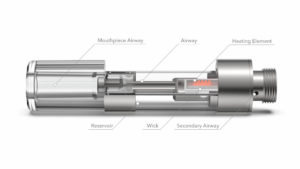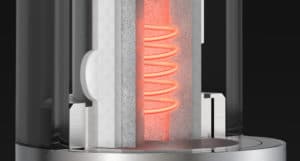How does vaporization actually work?
It’s not magic, it’s physics! To help you choose a vaporizer with the best performance, quality, and reliability, it helps to understand the science that is going on inside your device.
When you get how your vaporizer works, you can make better and safer choices about the device you buy, understand why some products work better than others, and use and store your vaporizer to avoid problems.
The Parts at Hand
To wrap your brain around how your vaporizer functions, you first need to understand the parts of the cartridge.
Starting from the top of the device, you have the airway, where you draw in air and vapor, and then the fluid reservoir, which holds the liquid extract. Below that is the wick, the most critical part of the cartridge, and at the bottom, the heating element. If anyone uses the term atomizer, they’re referring to a combination of the wick and the heating element.

A vaporizer’s wick works by transporting liquid from the reservoir to the heating element, which heats it up and turns it into a vapor that you can inhale. Just like when you heat up water and it boils and turns into steam, cannabis extract turns to vapor when the heating element does its job.
Ideally, you want even heating that can vaporize liquid steadily, so there’s always something to inhale, and the system never allows itself to dry out, which can cause burning — think of a dry kettle — and that not-so-great burnt taste.
The Wonder of the Wick
With CCELL® cartridges distributed by Jupiter Research, the wick is made of porous ceramic material — those pores are essentially tiny little openings. The liquid from the reservoir wants to coat and be absorbed by the ceramic, thanks to a property of physics called capillary action, which dictates that a liquid, by nature, wants to spread out and cover all surfaces.

The liquid will saturate the wick until it’s full, and then it’ll stop flowing. This natural phenomenon controls the flow rate of liquid, so you’ll never liquid over-absorbing, causing the wick to leak. Vaporizers that use capillary action don’t need a pump to move the liquid evenly to the wick — way to leverage science.
Temperature Matters
If the wick is made of a less ideal material or has a design flaw, it won’t naturally control the amount of liquid it takes in. If there’s not enough liquid entering the wick, it can dry out and burn. A well-designed wick made of the right material that absorbs just the right amount of liquid and can handle high temperatures is what you want.
Some vaporizers use a temperature control mechanism to prevent the liquid from burning — after all, these little devices run very hot. But CCELL® cartridges don’t need temperature control.
Capillary action makes sure liquid keeps flowing to the wick, so it never dries out and starts to burn. But also, when you heat something, and it changes state — say from a liquid to vapor — the temperature naturally stabilizes. That’s because changing the state of matter takes up energy. So the liquid in a CCELL® cartridge keeps flowing and vaporizing and never has a chance to overheat.
Ceramic can tolerate the high temperatures inside a vaporizer, and it won’t burn until it hits well over 1000 degrees Celsius.
Make Sure You Breathe
Vaporizer cartridges don’t look full, and that’s okay. The headspace leftover is important, as it allows something called breathing to happen. Breathing is the entry of air into the headspace as fluid leaves the chamber — you don’t want the liquid to exit and leave a vacuum. Jupiter’s CCELL® cartridges use larger inlet holes to increase the surface area that absorbs liquid and the capping process helps to create the right kind of pressure so the liquid will continuously and smoothly flow to the wick and not leak out into the airway or bottom of the cartridge.
Headspace also helps liquid saturate the wick quickly, so when you first start inhaling on the vaporizer the device starts to dispense vapor without delay.
Who knew a vaporizer was a little science experiment happening all the time? Well, it is, and understanding some of the principles behind how things move and heat up can help you buy the right vaporizer, and take the best care of the one you have.